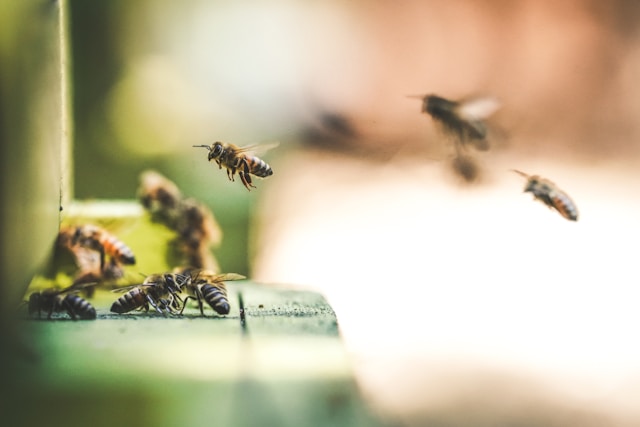Honeybee colonies are helping to boost the numbers of the once-ailing insects. While environmentalists form a huge part of the group that’s leading the resurgence of the humble honeybee, amateurs are also taking up bee husbandry, as it was once known. Even among amateurs who do not see apiculture as a means of making money, there are ways to yield returns, and we’re going to look at some of the financial rewards of beekeeping here today.
Your Bee Farm’s Honey Yield
Ultimately, honey is the number one product of keeping bees. It is your most saleable asset, but how valuable it is to a bee farmer depends greatly on your yield. At the lower end of the scale, an average-sized bee farm can produce around sixty pounds of honey annually. If the weather conditions are just right, and there is a lack of predators, few bees abscond from their colonies, and you’ve got the necessary skills and equipment, it may be possible for your bee farm to yield around a hundred pounds of honey per annum.
Sellable Products for Bee Farmers
Many amateur bee farmers believe that honey is the only sellable asset from apiculture. That’s not true, though. A seasoned veteran knows that there are a few other products you can take to market with your bee farm. We’ll touch on those shortly, but first, let’s begin with the big one – the honey.
Pure, Organic Honey
On average, and at the time of writing, honey will typically sell for around five to six bucks a pound. In the past, it has dipped as low as $2, but thankfully, things have changed. If you sell pure, organic honey, then at wholesale prices, you can look at bagging around $10 a pound.
For those with sketchy mathematics, the average-sized bee farm (with a total yield of around eighty pounds) will see you make $450 a year, give or take. Naturally, that’s a long way from being hugely profitable as a business. If you intend to make honey production a viable business model, you’ll need anything from sixty to seventy-five colonies.
Wax
Wax is a precious commodity, and it’s primarily taken from bees. Its primary markets are the manufacture of candles, soaps, and quite a lot of cosmetics – even hair products. Wax is more valuable than you might believe, and your bees may generate around a pound a year of the stuff, which you can also take to market.
Royal Jelly
Secreted by queens and notable for its anti-inflammatory and antioxidant properties, Royal Jelly also has a price tag attached to it. A good colony will produce up to two pounds a year, netting you roughly $250. Its practical use for lowering cholesterol, blood sugar, and other symptoms may not be scientifically verified, with royal jelly remaining more of a homeopathy cure than anything else, but it’s still a financially viable one for bee farmers.
Pollen Traps
Pollen traps are a risk for bee farmers. Set up in a hive, they will trap some pollen from foraging bees when they enter the colony. This can then be harvested by the beekeeper. Around 500 to 1,000 ounces a year is possible in a big colony. At prices varying from three to five bucks an ounce, there’s a couple of thousand dollars’ worth of pollen to be harvested there.
However, a word of warning – removing pollen via these traps will slow down the production of honey, which hits your pocket in a different way. If too much pollen is harvested, the bees may abscond, effectively killing the colony.
The Entire Colony
Another alternative is for you to sell the entire colony. Beekeeping is becoming popular around the world, and all new farmers require an initial colony. Selling a single colony to newbies could generate $150 apiece. It is also possible to keep the nucleus of the colony intact and simply sell so-called “packaged bees”, namely a Queen and a handful of workers, to a budding bee farmer who has their own empty hive setup. This will generate significantly less income than selling the entire colony.
Bee Farm Expenditure
As you can see, there are ways to generate revenue from bee farming. However, it isn’t without its costs. Thankfully, apiculture isn’t overly costly to get involved in. The cost of a smoker, bee suit, colony, brushes, and the bees should set you back just a few hundred dollars, and colonies can be maintained for around $500 a year.
However, there are some other hidden expenditures. For instance, you can’t expect any honey to be made within the first year. Secondly, you’ll need land that has watering and flowering flora within five miles, and your colonies must be shaded and far from any pesticides. You don’t need acres, but you do need space. This can cost extra if you don’t already have that setup in place.
Can I Make Money with Bees?
In theory, you can make money from beekeeping. You’ll need patience and revenue to sustain your first year, as most colonies won’t begin honey production for a year or two. Beekeeping can be a pleasurable experience with a single hive, but that isn’t sustainable for a business model. To get anywhere near a livable median wage and make it your full-time job, you’ll need dozens of colonies.
If you’ve got a job with a reliable source of income and want to practice bee husbandry on the side (while still making it profitable), you can get by with just a handful of colonies. While it is important to weigh up the financial rewards and risks associated with apiculture, it’s also a great way to feel good about yourself and give Mother Nature a helping hand.
